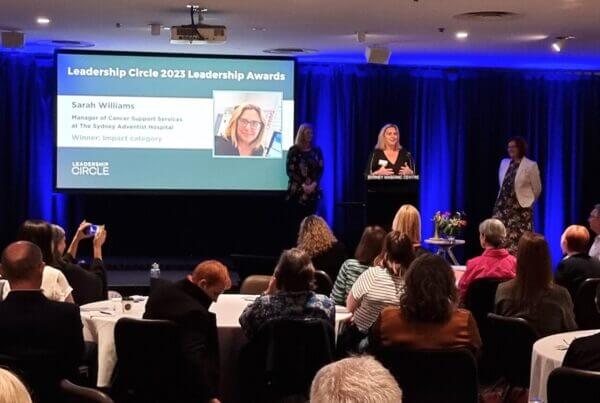Before takeoff, the flight attendants walk through the aisle broadcasting their safety messages. It always goes something like, “To start the flow of oxygen, pull the mask towards you. Place it firmly over your nose and mouth, secure the elastic band behind your head, and breathe normally. If you are traveling with a child, or someone who requires assistance, please secure your mask before assisting the other person.”
If you’re a frequent traveler, you’ve probably tuned this part of the flight out long ago, instead choosing to check any last-minute messages or attempt to organize your kid’s 47 items they just had to carry on before takeoff. But, if you think about it, it’s not only life-saving advice in case of an emergency, it can apply to the world of leadership.
It is imperative for a leader of any organization, large or small, to know exactly where their business is going and be able to clearly articulate this to the masses in a way that’s both persuasive and consistent. They must also embrace and prepare for change and constantly challenge the way their business is running and the value they’re adding to their clients in order to stay one step ahead of their competitors —but that’s not all.
“Increasingly, the issues that affect business are global in scope. Organizations are nested in a storm-tossed sea of global change where everything affects everything else,” Bob Anderson, Founder, Chairman & Chief Development Officer of Leadership Circle says. “Issues of cross-cultural commerce, global economic shifts, resource constraints, ecological impact, and geo-political (in)stability are redefining the context of leadership.”
Anderson also mentions in his white paper The Spirit of Leadership that a recent study of more than 100 companies working to try to adapt and transform found that 85 percent don’t yield tangible, much less durable, results. So, why is this?
Meg Wheatley, renowned author of Leadership and the New Science, suggests that “Most of the ways we were taught to think, to reason, to understand simply don’t give us the means to make wise decisions anymore. We don’t know how to be wise stewards of the dilemmas and challenges that confront us daily. We were not taught how to make sense of a chaotic world, or a world-wide interconnected web of activity and relationships.”
This interconnection between personal and organizational transformation is the “oxygen” leadership must achieve in order to successfully govern. Determining the best, most efficient way to obtain their “oxygen” isn’t an easy undertaking. Without it, however, both they and their organization will not survive.
We’ve spent decades determining what dynamics shape a successful leader. In order to determine what makes each individual leader tick, we’ve taken into consideration both Creative Competencies and Reactive Tendencies and created The Leadership Circle Profile, a 360-degree tool designed to help individuals identify their strengths and limitations.
Creative Competencies are well-researched proficiencies that measure how aperson achieves results, brings out the best in others, leads with vision, enhances their own development, and acts with integrity and courage.
Reactive Tendencies are leadership styles that emphasize caution over creating results, self-protection over productive engagement, and aggression over building alignment. These self-limiting styles overemphasize the focus on gaining the approval of others, protecting oneself, and often lead a person to achieve results through high-control tactics.
We also look at personality, which we consider to be a leader’s unique Operating System. When taken into consideration, leaders can see how their Internal Assumptions (beliefs) run behaviors throughout their Creative/Reactive channels and how those beliefs translate into a productive or unproductive style of leadership.
“Unfortunately, too many leaders allow their egos and hidden agendas to stand in the way of doing what is best for the people and organizations they serve,” says Glenn Llopis, a contributor to Forbes and author of the article 4 Reasons Great Leaders Admit Their Mistakes. “Leaders are not responsible for always being right. However, they are accountable to see that problems become opportunities and solutions are proactively found so that momentum is never lost.”
It’s not an easy task to delve into where those hidden agendas live and from where they are cultivated. “We focus so much time on maximizing our strengths but not enough time on understanding how and why we fail,” says Llopis, “which is equally important to success in the marketplace.”
The Leadership Circle can help determine both the failures and what allowed those failures to transpire at a detailed level. Our goal is to help uncover the motivating habits in both thought and action, and address our internal assumptions that are causing those thoughts and actions. Basically, how those Reactive Tendencies interconnect with, and can often temper, the ability for our Creative Competencies (our “oxygen”) to show through.
In meeting with leaders from dozens of industries over the years, I’ve had the opportunity to examine the ease with which many slip into some of these Reactive Tendencies –Perfection, Pleasing, Ambitious, Autocratic, Passive, Arrogance –and I’ve found oftentimes it’s less a matter of their intrinsic values or feelings of superiority, but rather a product of how they believe a “true leader” should present to their organizations.
In many cases, they believe they must distance themselves from others in order to effectively lead. This aloofness, and what I like to call “perfectionism from a distance,” is meant to project an air of confidence and a measured detachment from employees so decision making on all fronts can be seen as neutral. Unfortunately, more often than not this leads organizations to feel disparate, disorganized, and purposeless.
In other cases, these Reactive Tendencies can originate from other reasons entirely, like gender. Researchers published a report in The Leadership Quarterly titled The Queen Bee Phenomenon: Why Women Leaders Distance Themselves from Junior Women, and found the phenomenon itself is a “consequence of the gender discrimination that women experience at work.” Essentially, this separation and aloofness is a result of and response to the discrimination many women experience in male-dominated organizations, also found with other marginalized groups. It’s not a matter of wanting to separate and lead from a distance, it’s an internal belief they must do so to survive.
There has been much research, however, that this type of leadership is counterproductive to success. We’ve found leaders with warm, intimate relationships with their subordinates are viewed in a more positive light by all of their colleagues. Their relationships are not only better, but they often produce higher customer satisfaction, have more dedicated employees who are brought into the overall mission, and ultimately produce higher profits for their organization.
Understanding and identifying these Reactive Tendencies and Creative Competencies as primary leadership domains are the backbone of the work and coaching we do at Leadership Circle. Our Leadership Circle Profile™ is the only 360-degree assessment to simultaneously measure the beliefs and assumptions that organize a leader’s behavior.
As such, this allows for deeper insight into the underpinnings of one’s leadership, where they get their “oxygen” from, and how they can provide this to their organizations most effectively to create individual and company success. It is our goal to support all leaders in navigating the delicate balance between “short-term profitability and long-term common good,” Anderson says. A balance that will ultimately allow a person’s leadership powers, and the powers of those around them, to shine.




